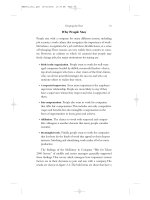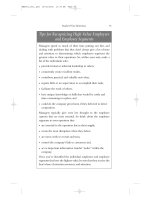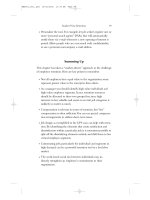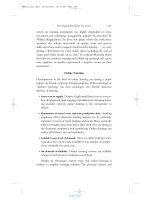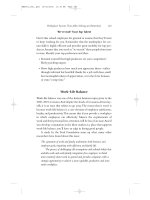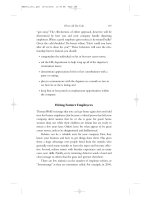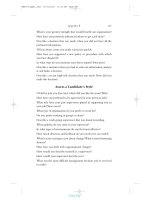Tài liệu Hiring and Keeping the Best People 4 pptx
Bạn đang xem bản rút gọn của tài liệu. Xem và tải ngay bản đầy đủ của tài liệu tại đây (127.64 KB, 8 trang )
your own department. Its purpose is to confirm that the candi-
date meets the qualifications stated in the ad or other recruiting
material, and it can be as short as necessary to accomplish that
goal. It is a good opportunity to get some initial impressions of
the candidate: Does she call you back at the specified time?
Does she communicate well?
2.
Initial in-person interview. Try to narrow the field to four to
seven candidates before holding an initial interview.This inter-
view will probably last 30 to 60 minutes. For less demanding
positions, you may find out everything you need to know about
the candidate in this interview. Otherwise, you will need to see
the person again.
3.
Second interview. Be very selective about who rates a second
interview.At this point, other people with a stake in the process
may participate, for example, direct reports, potential peers, or
other managers.This interview often brings out more of the
“real” person.
Structured versus Unstructured Interviews
In a structured interview, you ask all the candidates the same ques-
tions so you can compare answers. Structured interviews are used in
order to be fair and objective, but they may not elicit as much infor-
mation from the candidates. Unstructured interviews are individual
conversations that do not necessarily cover all the same questions
with every candidate. Instead, they follow lines of inquiry that
appear promising.You may learn more about the candidates, but it
will be more difficult to compare their responses.And you may miss
key information you need in order to make a decision.
It’s probably a good idea to steer a middle path between these
two approaches—i.e., be flexible in your line of inquiry, but be sure
that all interviewees respond to a core set of questions. By preparing
those core questions in advance, you can assure yourself and the
decision-making team that all key points are covered, and that
all candidates respond to them. The unstructured element of the
The Hiring Process 11
HBE001_ch1_.qxd 10/03/2002 2:47 PM Page 11
interview opens the door to productive areas of inquiry that neither
you nor your colleagues may have anticipated.
Be Prepared
Would you go into a meeting with a vendor to discuss a $500,000 to
$1 million custom software package without preparation? Hope-
fully, you would not. You’d give lots of thought to what you
expected the software to do and the features you needed. You’d
probably formulate a list of key issues to discuss. Chances are your
hiring decisions are costing you something in this same range. So,
should you walk into a job interview with notes and prior prepara-
tion, or should you simply wing it?
You will gather more of the information you need to make a
good hiring decision if you take the time and trouble to prepare.To
prepare for a hiring interview, review the job description and make
a list of the key responsibilities and tasks of the job, associated train-
ing and experience needed, and personal attributes required to
do the job well. For each of the areas you need to explore with
the candidate, prepare several questions in advance. Figure 1-1,
the Interview Preparation Form, is a handy way to organize your-
self and gives you something you can take into the interview
itself. (For an interactive version of this tool, please visit www.
elearning.hbsp.org/businesstools.) For consistency, other interview-
ers should use the same form but ask their own questions.
There are three phases to the interview: the opening, the body,
and the close. Let’s consider each in detail.
The Opening
Generally, this should take about 10 percent of the allotted time.
Your goal in this phase is to make the candidate feel sufficiently
comfortable to open up.There are several things you can do to cre-
ate this sense of comfort. Be on time. Be friendly. Introduce yourself
and tell the candidate something about yourself. Explain the struc-
ture of the interview:
12 Hiring and Keeping the Best People
HBE001_ch1_.qxd 10/03/2002 2:47 PM Page 12
The Hiring Process 13
FIGURE 1-1
Interview Preparation Form
Job Title:
Key Responsibilities and Tasks
Associated Training and/or Experience
1.
2.
3.
4.
1.
2.
3.
4.
Personal Attributes to Look For:
Key Areas to Explore
Questions to Ask
Notes
Education
Previous Experience
Job Accomplishments
Skills and Knowledge
Personal Attributes
Previous Appraisal or
Rating
1.
2.
3.
1.
2.
3.
1.
2.
3.
1.
2.
3.
1.
2.
3.
1.
2.
3.
Source: HMM Hiring.
“I’m going to ask you about your experience.”
“I’m interested in finding out about you as an individual.”
“We’re interested in finding out whether there is a good fit
between your interests and abilities and our organizational
needs.”
HBE001_ch1_.qxd 10/03/2002 2:47 PM Page 13
“I will give you information about our organization.”
“I’ll be glad to take your questions at the end of the interview.”
You should also use this interview phase to establish rapport with
the candidate.Acknowledge some of the difficulties or awkwardness
of being interviewed, such as meeting a lot of new people or being
tired at the end of the day.A little humor is generally effective in dis-
pelling the tension that undermines communication. Find informa-
tion on the résumé that will help you build rapport, or compliment
the person on some aspect of his experience.Acknowledge that you
have something in common, such as having lived in the same city, a
mutual acquaintance, or the same outside interest.
The Body
Plan to use 80 percent of your allotted time in this phase. Use that
time to gather the information you will need to evaluate the candi-
date and to “sell” your organization. During the body of the inter-
view, you need to assess the candidate’s qualifications, skills, knowl-
edge, and experience and compare those to the job description you
have created. Pursue a direct line of questioning based on the
résumé. Identify similarities and patterns of behavior consistent with
your ideal profile.Ask for samples of work and references to review
after the interview. Samples, if they are not confidential or propri-
etary, may include a sales brochure, product, customer survey, or
training course designed by the candidate.These samples can tell you
a great deal about a candidate’s capabilities. It is sometimes difficult
to get a candidate to be specific about the accomplishments listed on
their résumé. But don’t allow difficulty to stand between you and
the information you require. Remember, a mistake in a hiring deci-
sion can be costly and difficult to undo, and enormously expensive if
the person is applying for a key decision-making post. So ask directly
for details, and probe for tangible measures of success.Table 1-1 pro-
vides some examples of typical résumé statements and how you can
respond in order to get more detail.
You are also assessing the candidate’s personal qualities during
this phase, such as leadership, problem-solving ability, communica-
14 Hiring and Keeping the Best People
HBE001_ch1_.qxd 10/03/2002 2:47 PM Page 14
tion, teamwork skills, and motivation. Use scenario-based questions
to determine how people tend to handle situations, such as:
•
For a process manager candidate: “Suppose that the loan
processing department you’d be managing in this position was
taking two days more than its competitors to make its decisions
and notify customers. How would you approach that type of
problem?”
•
For a sales manager candidate: “Let’s say that one of the people
in your sales district was well liked by customers and company
personnel, had great potential, but wasn’t pulling her weight
after two years on the job. How would you deal with a situation
like that?”
Responses to scenario questions like these will give you an idea
about how the candidate approaches problems.
Also, ask the candidate about how he or she handled past situa-
tions similar to those he or she would likely encounter as one of
your employees: “Tell me about a time when you had to [fire an
employee/handle a key customer whose business you’d just lost/lead
a process improvement team/etc.].” Be on guard, though, as some
The Hiring Process 15
TABLE 1-1
Responses to Typical Résumé Statements
Résumé Statement Possible Response
I successfully managed development of a
new line of consumer kitchenware.
I worked effectively with marketing and
sales to increase annual unit sales by 25
percent over the past twelve months.
I initiated the redesign of key department
processes.
How was success measured: by rev-
enues, time-to-market, other measures?
Specifically, what was your role in the
development effort?
What was the nature of your contribu-
tion? How were unit sales increased: by
more effective selling or by slashing
prices?
What processes? What do you mean by
“initiated”? Why did you decide to do
this? Why was this initiative important?
HBE001_ch1_.qxd 10/03/2002 2:47 PM Page 15
people have developed canned responses to some of the more likely
scenario-based questions.
Maintaining control of the interview is very important (see
“Tips for Conducting the Interview” and “Case Study:A Take-No-
Prisoners Interviewer”). The key to maintaining control is to ask
most of the questions and do most of the listening.You should be lis-
tening 80 percent of the time.You can also maintain control by fol-
lowing a logical line of inquiry. If the candidate strays from this line,
return him or her to it.
Be sure to take notes during the interview. Notes will help
you recall significant facts about the candidate. But be unobtrusive
about it, and tell the candidate up front that you will be taking notes.
Remember that your interview notes will become part of
the employment file. Avoid writing anything down that could be
construed as inconsistent with equal opportunity employment laws.
The Close
Plan on 10 percent of your allotted interview time to wrap things
up.The close is your opportunity to:
• Thank the candidate for coming in.
• Explain how and when the person will hear about follow-up
interviews or decisions, depending upon your company’s policy
and your interest in him or her.
• Ask if the candidate has questions, especially those that might
affect his or her decision to participate in the next step of the
process. If you have reached the interview’s time limit, invite
the person to call you later with further questions.
• Ask whether there is anything that has not been covered or is
unclear.
• Promote your organization.Remember to target the features
of your organization that are most likely to appeal to the
candidate.
16 Hiring and Keeping the Best People
HBE001_ch1_.qxd 10/03/2002 2:47 PM Page 16
The Hiring Process 17
Brad Smart is an industrial psychologist who specializes in a
“chronological in-depth structure” interview, or CIDS, and
“topgrading,” his term for a lengthy, rigorous executive grading
process applied to both incumbent managers and job applicants.
As described in a Fortune interview, Smart’s goal is to identify
“A” players, whom he defines as individuals who represent the
best-in-class in their job categories.
a
These, he says, are the top
10 percent of the talent available within particular categories.
Smart’s interview methodology is more intense than what
usually passes for good practice. For example, he asks every seri-
ous candidate hundreds of questions about his or her life and
career, going back to the person’s school years. He inquires
about every job and every boss the candidate has had. And to
insure that the responses he gets are truthful, Smart lets them
know in advance that he will speak with every one of the person’s
bosses over the previous ten years, as well as many of their direct
reports. So when he asks them,“What would your former bosses
describe as your strengths, weaknesses, and overall perform-
ance?” they know they must be absolutely truthful.
Smart was motivated to develop his detailed method by an
experience he had observing traditional interviews. As he
explained to Fortune:
I got an epiphany while working for a human resources manage-
ment consulting firm 28 years ago. One day my boss asked me to
sit in on a job interview to screen a candidate for a client looking to
hire a vice president of marketing. I noticed the interview was an
hour and a half of general scattergun questions, none of which
probed the patterns of how this person developed competencies
throughout his career. Things like: “Tell me about yourself” and
“How would you handle this?” I immediately saw flaws in the
process. Six executives of the client had different opinions about
what the job was.They really hadn’t analyzed it. I realized most
companies hire this way. So I decided to attack the problem.
b
Case Study: A Take-No-Prisoners Interviewer
continued
HBE001_ch1_.qxd 10/03/2002 2:47 PM Page 17
TEAMFLY
Team-Fly
®
• Shake hands and make eye contact.
• Walk the person to the door or to the next destination.
Some candidates will have questions about salary or benefits at this
stage. In some organizations, the human resource department ad-
dresses these questions. Others allow the interviewer to disclose the
salary or salary range.
Once the candidate has departed, immediately write down any
additional notes or observations while they are still fresh in your
mind.
Asking Questions
We’ve already given examples of some typical interview questions.
Questions put to the candidate are both a means of controlling the
interview and eliciting the information you need to effectively eval-
uate the prospective employee. It is important to remember, how-
ever, that there are good questions, there are aimless questions, and
there are outright bad questions. A good question has a purpose, is
tied to your decision-making criteria, encourages communication, is
job-related, and is nonthreatening. Good questions reflect favorably
on you and demonstrate your interest and your preparation. Good
questions include:
• Self-appraisal questions that require the candidate to give some
thought to his or her interpersonal skills and abilities.These
allow the candidate, rather than you, to interpret the facts. (For
18 Hiring and Keeping the Best People
Smart estimates that nearly 50 percent of all management-level
positions hired through these unsystematic, undisciplined meth-
ods are eventually recognized as “mis-hires.”
a
Hank Gilman and Lori Ioannou,“The Smart Way to Hire Superstars,”Fortune, 10 July 2000, online edi-
tion, www.fortune.com.
b
Ibid.
HBE001_ch1_.qxd 10/03/2002 2:47 PM Page 18
